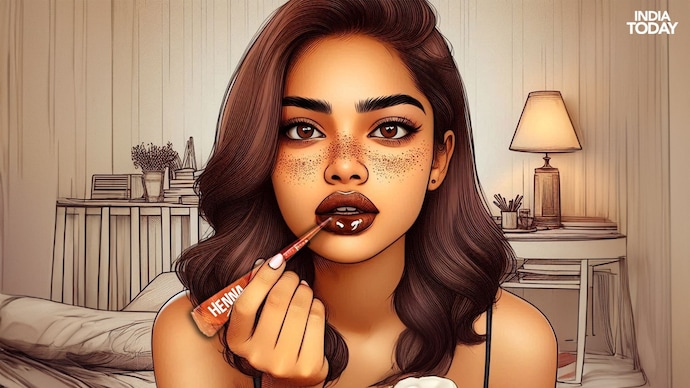Listen to Story

In other words
- Henna is a medical plant, and mehendi is made from its dried leaves
- The henna cones offered in the market consist of hazardous chemicals
- Henna is safe for thicker skin locations however need to not be used to delicate locations
For a lot of us, henna (or mehendi) is mostly a way to decorate our hands and feet with sensational styles. On daring days, we may even utilize it in our hair for a tip of reddish colour, thinking it to be a much safer option to severe hair dyes. In the ever-evolving landscape of social media, surprises are constantly around the corner.
A couple of months back, the pattern of synthetic freckles removed, with influencers producing fragile dots on their cheeks and noses utilizing henna cones to attain a freckled appearance.
Now, the henna pattern has actually reached brand-new heights, with individuals exploring by utilizing it for full-face makeup—– using it as eye liner, lip tint, and more. While imagination is constantly amazing, this is one social networks pattern you may wish to avoid!
Laden with chemicals
Henna is the name of a medical plant (Lawsonia inermis), and mehendi is made from the dried leaves of the henna plant. The leaves are ground into powder or paste and utilized as dyes.
Dr Piyusha Bhagde, creator and chief skin doctor at Skin Ethics Clinic, Akola, Maharashtra, informs India Today that the mehendi stemmed from the henna plant has an active component called lawsone, which offers it an orange-red colour by oxidation on contact with skin.
The physician includes that the henna offered in the market consists of lots of active chemicals like p-phenylenediamine (PPD), silver nitrate, carmine, and chromium.
To this, Dr Aditi Wadhwa, expert, department of dermatology, Sharda Care, NCR, includes that paraphenylenediamine (PPD) is typically discovered in black henna. This is an artificial color utilized to produce a really dark stain. Natural henna produces a reddish-brown colour, so if an item provides a jet-black colour, it most likely consists of PPD.
Salt picramate is a chemical that is in some cases included to henna to make it stain darker or appear more lively.
Dr Wadhwa even more informs us that pre-mixed henna pastes might include preservatives or stabilisers to increase service life, which are not present in natural henna.
“All these are understood to trigger allergies like itching, burning, inflammation, blisters, and even scarring of the skin,” Dr Bhagde shares.
You may also like
What is the denim fashion scene like at the moment?
In the baggy vs slim denims fight, what's ruling the style scene in India today? Know it from market specialists and the recently-concluded Lakme Fashion Week. Listen to Story Live television Share Denims in focus at...
What doctors say about Rapamycin, the magic pill that can ‘extend your life’
Rapamycin has actually gotten considerable attention from 'durability professionals' as the secret to a longer, much healthier life. Listen to Story Live television Share Rapamycin is offered in India as an...
Are dehydrated vegetable chips a healthy snacking option?
As India is going through a wise snacking transformation - experiencing an increase in need for much healthier treat choices - dehydrated veggie chips are likewise making their existence felt in the scene. Listen to...
Users Visit
- 21-year-old Jeswin Aldrin shatters long jump national record with world leading distance
- Samsung Galaxy Tab S9 series launched with S Pen and Snapdragon 8 Gen 2 SoCCheck details
- Rinku Singh is a player of different calibreHarbhajan Singh backs KKR batter to make India debut soon
- OnePlus Nord CE 3 Lite 5G first sale in India todayPrice,specifications and more
- A luxury sojourn at a quaint village in Goa. Bookmark for your next getaway
- This Chinese electric car has received 200 bookings in India in 8 days
- Pixel 7a India price leaked hours ahead of formal launch at Google IO, other phones have a cause to worry
- IPL 2023Good old format, renewed hopes as T20 cricket carnival returns home
- ExplainedHow government plans to control wheat prices during festive season
- Indian WellsHappy with the way I fought and dug in, says Emma Raducanu after beating Beatriz Haddad Maia
- BTS’ label Hybe introduces their first AI based artist, MIDNATT. New single Masquerade to drop on May 15
- Exclusive | Volkswagen expects higher sales contribution from Tier 2, 3 markets following network expansion
Recent Posts
- In the $320 billion global pet care industry, India is only catching up
- WTC Final qualificationIndia’s chances take massive hit after Pune Test loss
- OnePlus 13 to launch next weekIndia price, specs, and everything we may already know
- Twist in JioHotstar drama, Dubai siblings claim they bought domain from developer
- What nuts are best for your health, and when and how you should have them



